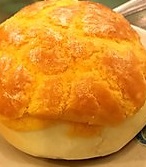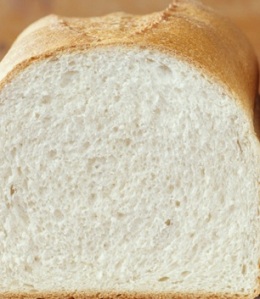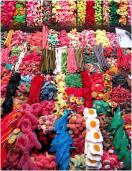Buying processed food may be more convenient than making wholesome meals from scratch, but are you aware of the hidden ingredients lurking in foods that may wreak havoc on your health? There are literally thousands of food additives out there, and a lot of them are at the root of many health problems. Here are 5 of the worst:
 1. Synthetic Trans Fats– Trans fats are artificially produced from industrial hydrogenation of vegetable oils. It makes food taste better, extends shelf-life and is often found in French fries, onion rings, fried foods, pies, pastries/ sweet rolls/ donuts, frozen dinners, margarine (In the 1980s, many consumers switched from butter to margarine because of concerns about butter’s high saturated fat content. But it turns out that synthetically made, trans fat margarine could be more damaging to your health than butter! If you must consume margarine, read the labels and buy one made without trans fats) and anything else containing “partially hydrogenated oils”. Industrially produced trans fats are bad for you. They are linked to heart disease and promote inflammation in the body (click here to read why inflammation is bad for you). They raise your bad (LDL) cholesterol levels and decrease your good (HDL) cholesterol. According to the FDA, a complete ban on partially hydrogenated oils can prevent 20,000 heart attacks and 7,000 deaths from heart disease in America a year. “The detrimental effect was found in studies where an increase in trans fat by 2% of the total calories of your diet will increase your cardiovascular disease risk by 23%. In comparison to saturated fat, an increase in 2% in saturated fat is only correlated to an increase of 2% in heart disease risk,” says June Chan, senior dietitian at the Hong Kong Sanatorium and Hospital. Some studies have also linked trans fat consumption with cancer, obesity, infertility and liver disorders. As of January 2014, Hong Kong has yet to ban trans fat from their menus and stores, though other countries have already taken measures to do so.
1. Synthetic Trans Fats– Trans fats are artificially produced from industrial hydrogenation of vegetable oils. It makes food taste better, extends shelf-life and is often found in French fries, onion rings, fried foods, pies, pastries/ sweet rolls/ donuts, frozen dinners, margarine (In the 1980s, many consumers switched from butter to margarine because of concerns about butter’s high saturated fat content. But it turns out that synthetically made, trans fat margarine could be more damaging to your health than butter! If you must consume margarine, read the labels and buy one made without trans fats) and anything else containing “partially hydrogenated oils”. Industrially produced trans fats are bad for you. They are linked to heart disease and promote inflammation in the body (click here to read why inflammation is bad for you). They raise your bad (LDL) cholesterol levels and decrease your good (HDL) cholesterol. According to the FDA, a complete ban on partially hydrogenated oils can prevent 20,000 heart attacks and 7,000 deaths from heart disease in America a year. “The detrimental effect was found in studies where an increase in trans fat by 2% of the total calories of your diet will increase your cardiovascular disease risk by 23%. In comparison to saturated fat, an increase in 2% in saturated fat is only correlated to an increase of 2% in heart disease risk,” says June Chan, senior dietitian at the Hong Kong Sanatorium and Hospital. Some studies have also linked trans fat consumption with cancer, obesity, infertility and liver disorders. As of January 2014, Hong Kong has yet to ban trans fat from their menus and stores, though other countries have already taken measures to do so.
 2. Preservatives– There is a trend lately among bread lovers. Many are ditching commercially made breads and making their own from scratch. One of the reasons is because they want to avoid the preservatives and additives often found in store-bought bread and bread products. Preservatives found in these foods include ammonium sulfate and potassium bromate, a harmful substance which improves the quality of flour. Potassium bromate can be harmful even at small doses, and it has been banned in Canada, Europe and China (including Hong Kong) though not in the U.S.A. Butylated hydroxyanisole (BHA) is a food preservative that prevents food from going rancid, but a recent study that found it causes cancer in laboratory animals. The U.S. Department of Health and Human Services has labeled BHA as “reasonably anticipated to be a human carcinogen.” You can also find BHA in medicines and food packaging. Butylated hydroxytoluene (BHT) is a food preservative similar to BHA that prevents oils in food from becoming rancid. You’ll also find it in jet fuel, embalming oil and rubber.
2. Preservatives– There is a trend lately among bread lovers. Many are ditching commercially made breads and making their own from scratch. One of the reasons is because they want to avoid the preservatives and additives often found in store-bought bread and bread products. Preservatives found in these foods include ammonium sulfate and potassium bromate, a harmful substance which improves the quality of flour. Potassium bromate can be harmful even at small doses, and it has been banned in Canada, Europe and China (including Hong Kong) though not in the U.S.A. Butylated hydroxyanisole (BHA) is a food preservative that prevents food from going rancid, but a recent study that found it causes cancer in laboratory animals. The U.S. Department of Health and Human Services has labeled BHA as “reasonably anticipated to be a human carcinogen.” You can also find BHA in medicines and food packaging. Butylated hydroxytoluene (BHT) is a food preservative similar to BHA that prevents oils in food from becoming rancid. You’ll also find it in jet fuel, embalming oil and rubber.
 3. Artificial Sweeteners– Artificial sweeteners, which virtually add no calories to your diet, can be found in a variety of foods and beverages labelled as “diet” or “sugar-free”. Soft drinks, fruit juice, chewing gum, breath mints (click here if you want to stop using breath mints!), baked goods, candy, ice cream and yogurt are some of the most common foods that may contain these sugar substitutes. The problem with these artificial sweeteners is some of them have been associated with different cancers (in mice), and many people actually experience a host of side effects after consuming them- abdominal cramping, diarrhea, dizziness, anxiety, aching joints, neurological problems such as seizures and headaches, etc. Beware of aspartame, sorbitol (One patient complained of constant diarrhea, which disappeared when I advised him to stop chewing his “sugar-free” gum which contained sorbitol!), acesulfame-K, sucralose and saccharin. A healthy piece of advice: Train your taste buds to savour a less sweet taste by gradually cutting back on sugar and artificial sweeteners. Eventually, you’ll enjoy your cup of coffee/ tea, bowl of cereal/ oatmeal just fine without any added sweeteners. Your body will thank you, too!
3. Artificial Sweeteners– Artificial sweeteners, which virtually add no calories to your diet, can be found in a variety of foods and beverages labelled as “diet” or “sugar-free”. Soft drinks, fruit juice, chewing gum, breath mints (click here if you want to stop using breath mints!), baked goods, candy, ice cream and yogurt are some of the most common foods that may contain these sugar substitutes. The problem with these artificial sweeteners is some of them have been associated with different cancers (in mice), and many people actually experience a host of side effects after consuming them- abdominal cramping, diarrhea, dizziness, anxiety, aching joints, neurological problems such as seizures and headaches, etc. Beware of aspartame, sorbitol (One patient complained of constant diarrhea, which disappeared when I advised him to stop chewing his “sugar-free” gum which contained sorbitol!), acesulfame-K, sucralose and saccharin. A healthy piece of advice: Train your taste buds to savour a less sweet taste by gradually cutting back on sugar and artificial sweeteners. Eventually, you’ll enjoy your cup of coffee/ tea, bowl of cereal/ oatmeal just fine without any added sweeteners. Your body will thank you, too!
 4. High Fructose Corn Syrup (HFCS)- This high-fructose sweetener is added to nearly every sweetened food or beverage. Soft drinks, breakfast cereals, cereal bars, commercial sauces and salad dressings are some of the more common products containing HFCS. Continuous consumption of HFCS leads to obesity, high triglycerides, fatty liver, diabetes mellitus and metabolic syndrome leading to heart disease. Furthermore, due to chlor-alkali products used in the manufacturing process, HFCS often contains toxic levels of mercury. Check out the health tip under #3 above.
4. High Fructose Corn Syrup (HFCS)- This high-fructose sweetener is added to nearly every sweetened food or beverage. Soft drinks, breakfast cereals, cereal bars, commercial sauces and salad dressings are some of the more common products containing HFCS. Continuous consumption of HFCS leads to obesity, high triglycerides, fatty liver, diabetes mellitus and metabolic syndrome leading to heart disease. Furthermore, due to chlor-alkali products used in the manufacturing process, HFCS often contains toxic levels of mercury. Check out the health tip under #3 above.
 5. Artificial Colours- Some parents may notice that after consuming artificially coloured foods (colourful cakes, cupcakes, cookies with icing, etc.), their children’s behaviour becomes erratic and often difficult. This behaviour change is largely caused by the chemicals used to make the dyes. A study commissioned by the British Food Standards Agency has linked artificial food colours to increased levels of hyperactivity and attention deficit hyperactivity disorder (ADHD) in ordinary children. Click here to read more on artificial colours and their detrimental effects.
5. Artificial Colours- Some parents may notice that after consuming artificially coloured foods (colourful cakes, cupcakes, cookies with icing, etc.), their children’s behaviour becomes erratic and often difficult. This behaviour change is largely caused by the chemicals used to make the dyes. A study commissioned by the British Food Standards Agency has linked artificial food colours to increased levels of hyperactivity and attention deficit hyperactivity disorder (ADHD) in ordinary children. Click here to read more on artificial colours and their detrimental effects.
If you haven’t started yet, now is a good time to start reading food labels! The food choices you make now not only impact your own health but also the health of your family (it may even impact your ability to conceive and have children. Click here to read more.). Hippocrates, known as the Father of Medicine, once said, “Let food be your medicine.” So, let food be our medicine, not poison.
If you suspect your health condition is caused by certain foods or additives- and want a thorough medical investigation- or if you want nutritional support and guidance, contact Dr. Yik today.
SOURCE:
Dufault, R., LeBlanc, B., Schnoll, R. et al. 2009. Mercury from chlor-alkali plants: Measured concentrations in food product sugar. Environ Health. 26(8):2.
Bray, G.A., Nielsen, S.J., and B.M. Popkin. 2004. Consumption of high-fructose corn syrup in beverages may play a role in the epidemic of obesity. Am J Clin Nutr. 79(4):537-43. Review.
http://www.thelancet.com/journals/lancet/article/PIIS0140-6736(07)61306-3/abstract
Great site. Lots of useful information here. I am sending it to several pals ans
also sharing in delicious. And of course, thanks in your sweat!